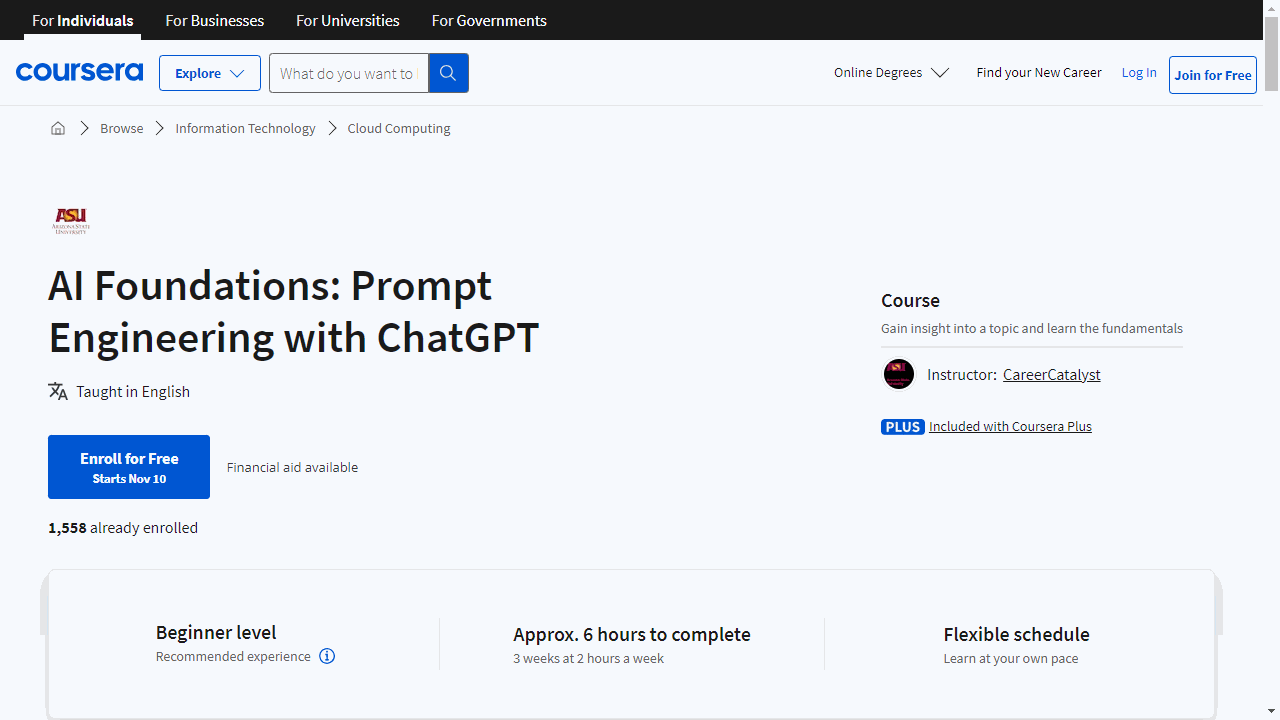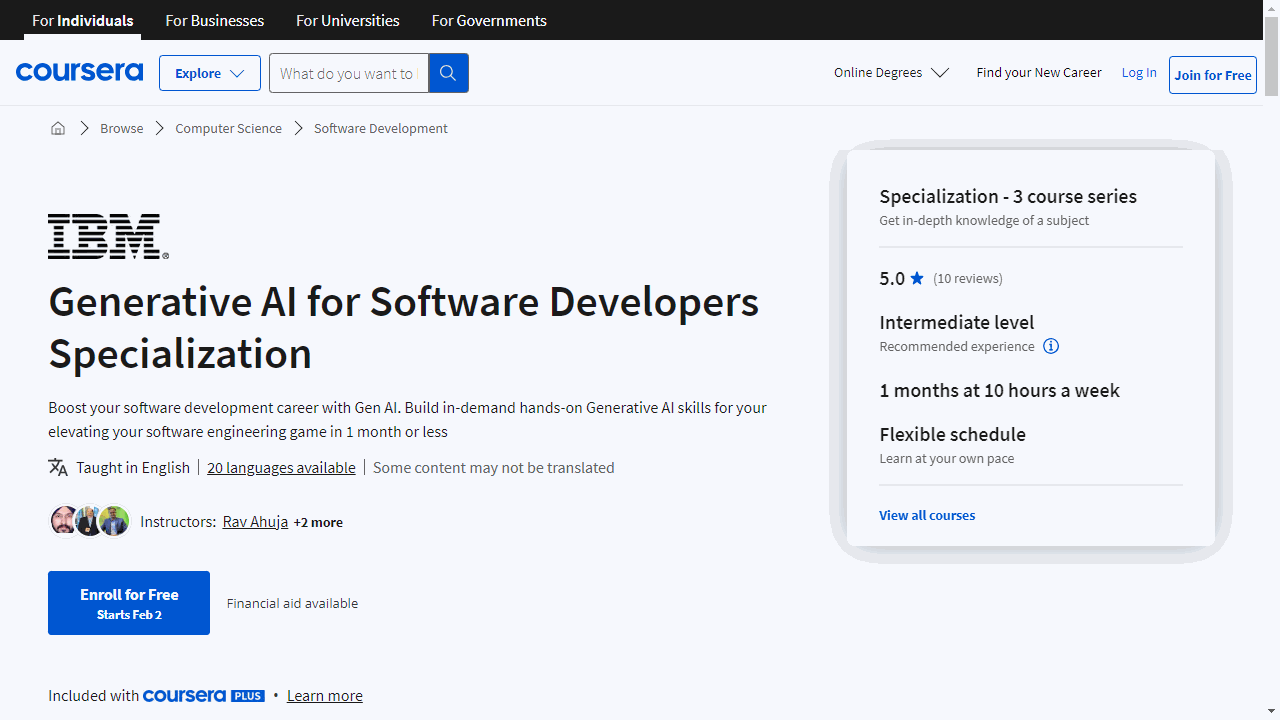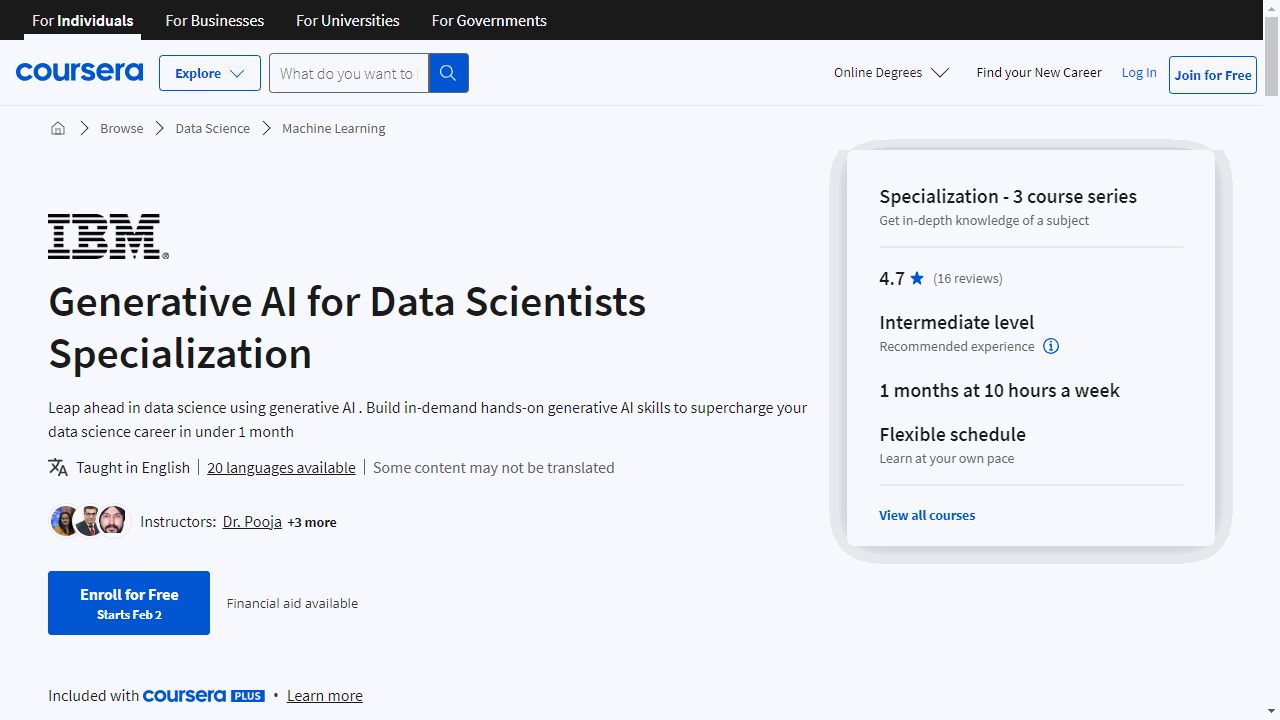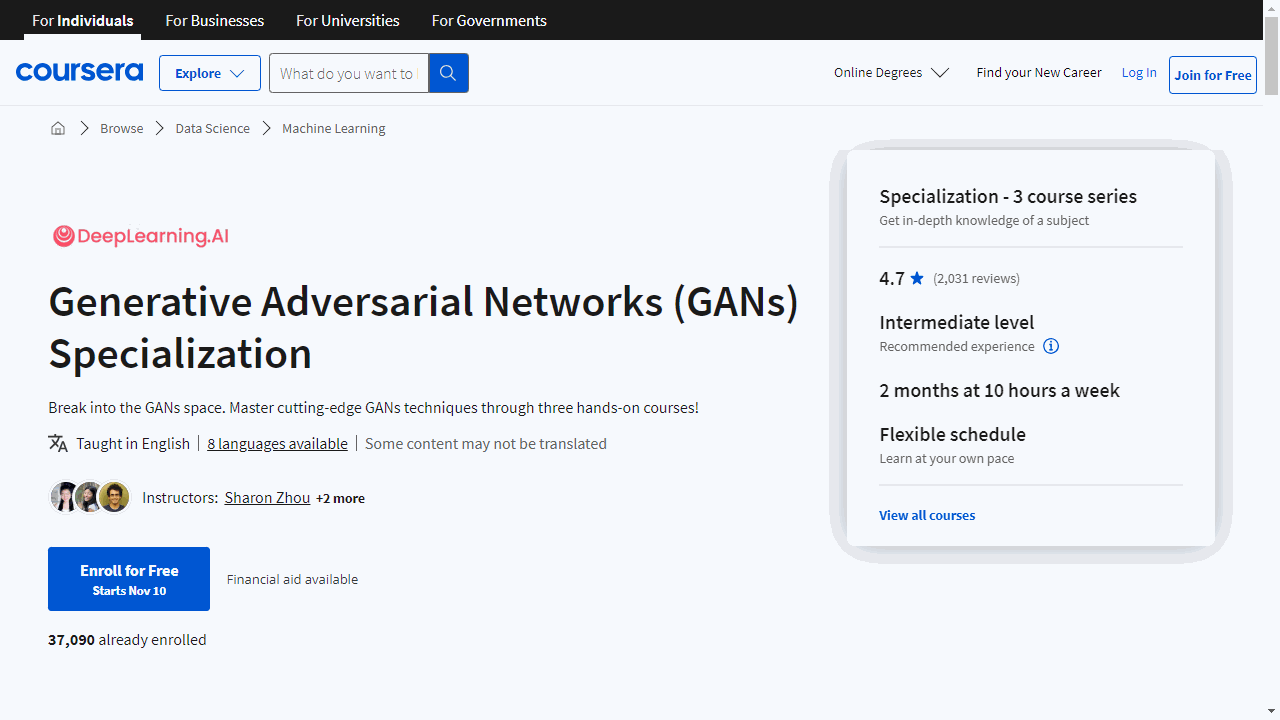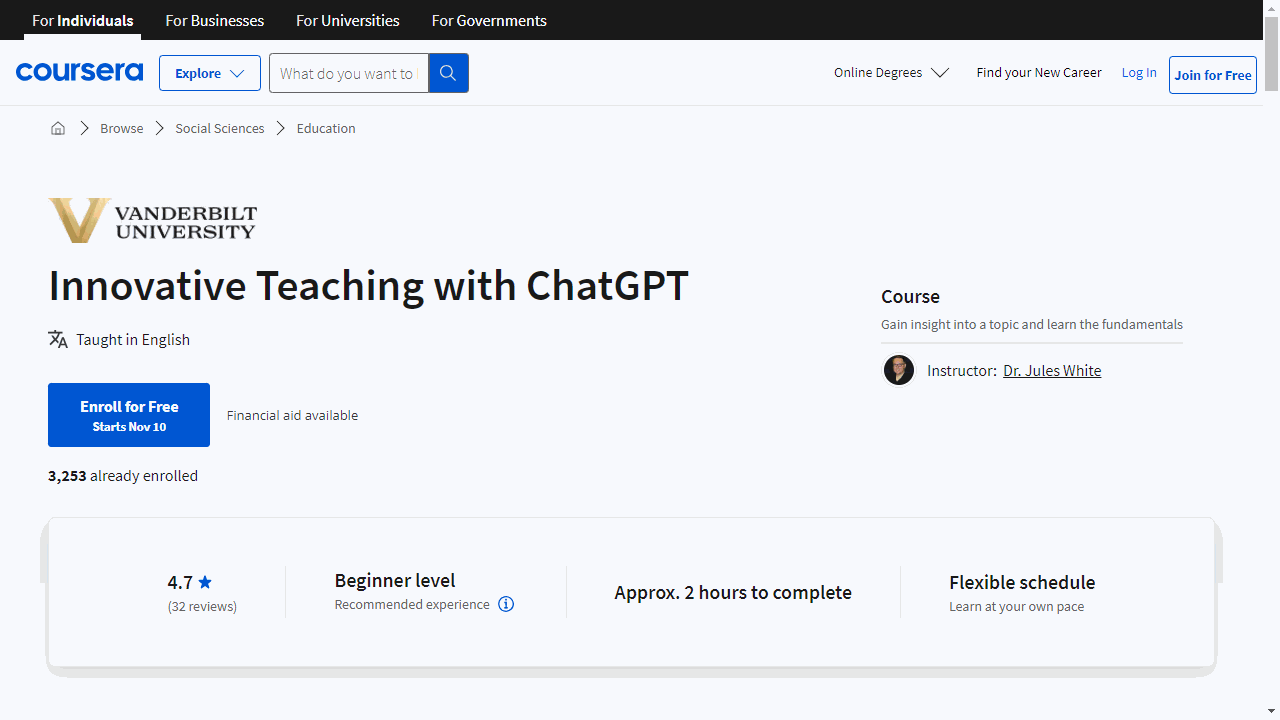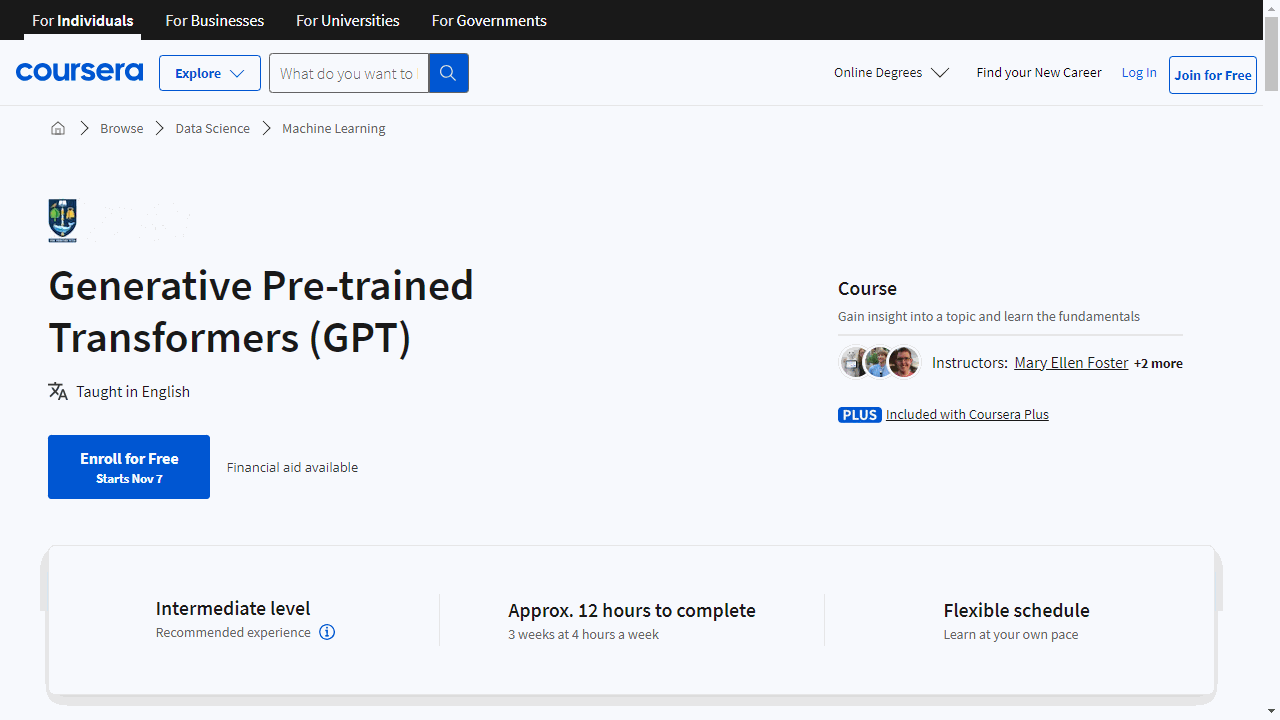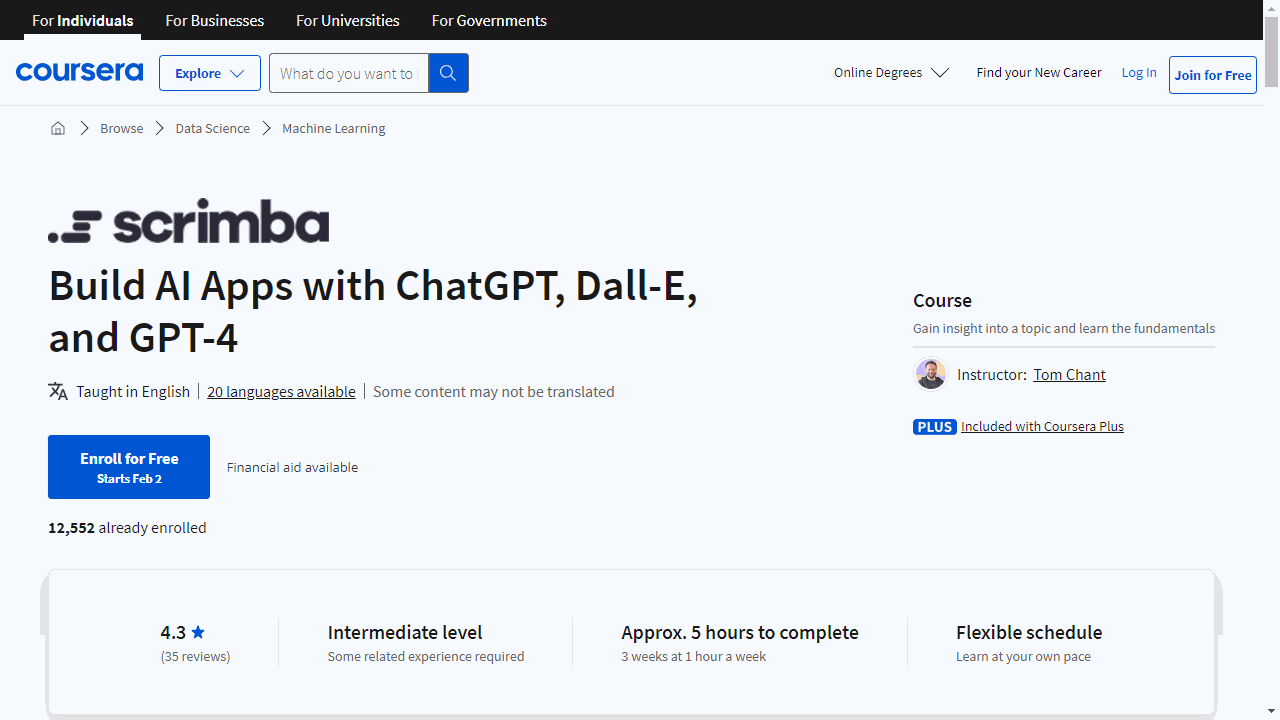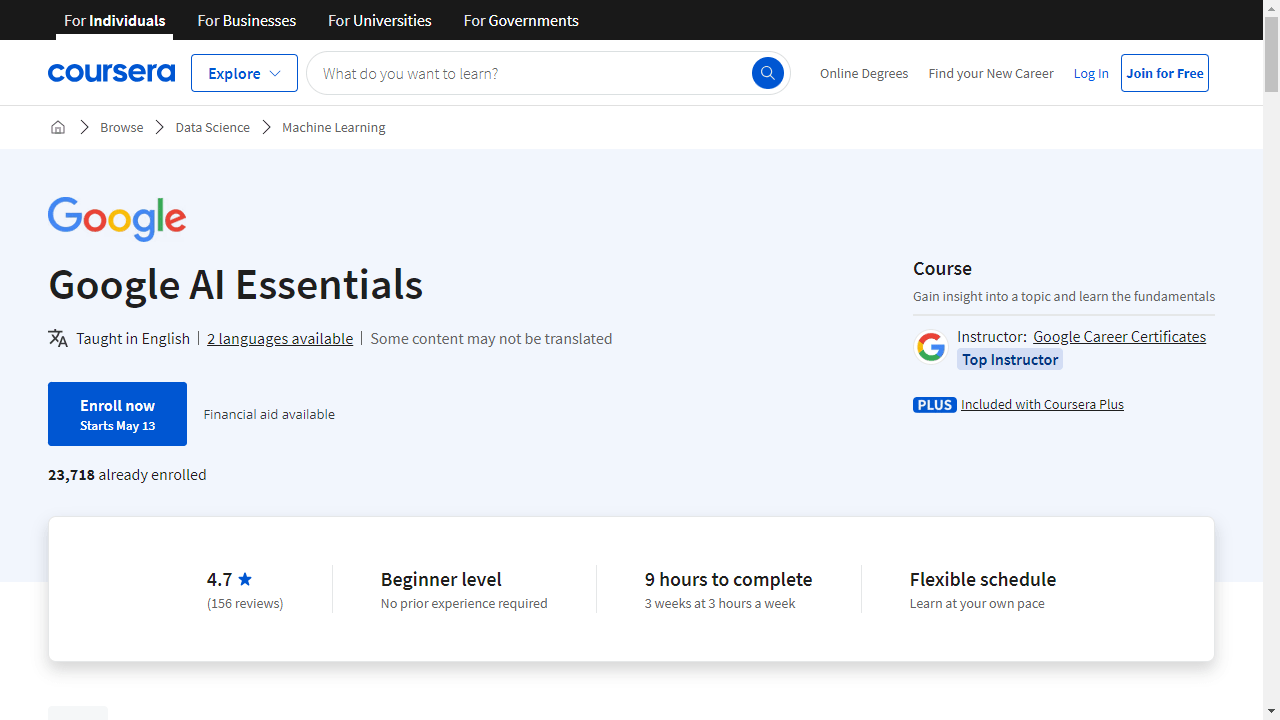Generative AI, a subset of artificial intelligence, focuses on creating new content such as text, images, videos, and audio.
This revolutionary field is rapidly transforming various industries, from marketing and entertainment to healthcare and scientific research.
By learning Generative AI, you can unlock exciting opportunities to create innovative applications, enhance creative workflows, and contribute to the advancement of this cutting-edge technology.
Finding the right Generative AI course on Coursera can be overwhelming, with so many options available.
You want a program that’s comprehensive, engaging, and taught by experts, but also fits your learning style and goals.
For the best Generative AI course overall on Coursera, we recommend the Generative AI with Large Language Models specialization offered by DeepLearning.AI.
This program provides a comprehensive introduction to the world of Large Language Models (LLMs), exploring their capabilities, applications, and ethical considerations.
The course emphasizes practical skills, teaching you prompt engineering, fine-tuning models, and integrating LLMs into real-world applications.
This hands-on approach makes it a great choice for both beginners and those with some experience in AI.
While this is our top pick, there are other great Generative AI courses available.
Keep reading to discover our curated list of recommendations, tailored to different learning levels and specific areas of interest within Generative AI.
Prompt Engineering Specialization
This series of courses, offered by Vanderbilt University, is designed to equip you with the skills to harness the power of tools like ChatGPT (OpenAI) effectively.
The course “Prompt Engineering for ChatGPT” is a comprehensive introduction to becoming a proficient user of generative AI.
You’ll learn to craft prompts that tap into the AI’s capabilities, enabling you to tackle a wide array of tasks more efficiently, from writing and summarization to complex problem-solving.
Moving on, “ChatGPT Advanced Data Analysis” is a practical course that teaches you to leverage AI for data science tasks without needing a background in programming.
You’ll discover how to transform raw data into compelling presentations, extract valuable insights from documents, and even automate routine content creation.
This course is about enhancing your ability to handle data with the help of AI, making your workflow more efficient.
Lastly, “Trustworthy Generative AI” addresses the critical aspect of reliability in AI outputs.
This course provides strategies for selecting suitable problems for AI, designing prompts that minimize risks, and verifying the information generated.
It’s about building a foundation of trust in the AI’s capabilities and integrating it into your creative and analytical processes.
The focus is on practical application, ensuring that what you learn will have real-world benefits.
AI Foundations: Prompt Engineering with ChatGPT
The journey begins with an orientation by Andrew Maynard, who sets the stage for what you’ll learn. This isn’t just a cursory overview; it’s a detailed roadmap to help you navigate the course with confidence.
You’ll then delve into the core principles of ChatGPT, framed by the RACCCA Framework.
This acronym stands for Relevance, Accuracy, Completeness, Clarity, Coherence, and Appropriateness, and it’s a systematic approach to crafting prompts that yield meaningful AI responses.
As you progress to Module 2, the course shifts from theory to application.
Here, you’ll start to see the power of your new skills in action. You’ll practice creating prompts that leverage ChatGPT’s capabilities, gaining valuable experience that goes beyond textbook learning.
The course also introduces Prompt Templates, a practical tool that streamlines your interactions with AI.
These templates are not just time-savers; they’re a way to achieve consistency and precision in your prompts, much like following a well-tested recipe ensures a great meal.
In the section on Imaginative Prompt Engineering, creativity takes center stage.
This part of the course empowers you to ask innovative questions and push the boundaries of what you thought possible with AI.
It’s an opportunity to blend your unique ideas with the technical prowess of ChatGPT.
Generative AI for Everyone Specialization
The journey begins with “Generative AI: Introduction and Applications,” a course that is designed not just for tech experts but for anyone with an interest in AI.
You’ll delve into the evolution of generative AI, understand its impact across various domains, and get hands-on experience with leading AI models.
After finishing, you’ll be able to articulate the nuances of generative AI and its practical applications in the real world.
Moving on to “Generative AI: Prompt Engineering Basics,” this course demystifies the process of guiding AI to produce specific outcomes.
It’s about precision – learning to craft prompts that lead to high-quality results.
You’ll explore different techniques and gain insights into the best practices for prompt engineering.
The course equips you with the skills to effectively communicate with AI models to get the results you want.
In “Generative AI: Foundation Models and Platforms,” you’ll dive deeper into the core models that power generative AI.
This course provides a clear understanding of the technologies that underpin AI applications.
You’ll also get acquainted with various AI platforms, enhancing your ability to leverage these tools for innovative solutions.
Ethical considerations are paramount in AI, and “Generative AI: Ethical Issues, Considerations & Implications” addresses this head-on.
You’ll engage with the ethical dilemmas AI presents, from data privacy to bias.
This course encourages a thoughtful approach to AI development, ensuring you’re prepared to address and mitigate potential risks.
Lastly, “Generative AI: Future and Professional Growth” offers a forward-looking perspective.
It’s about envisioning the trajectory of generative AI and identifying how it can bolster your career.
You’ll explore emerging job roles and learn how to apply AI to enhance workplace efficiency.
Generative AI for Software Developers Specialization
Provider: IBM
This series equips you with the skills to harness generative AI in software development, focusing on the art of prompt engineering.
The journey begins with “Generative AI: Introduction and Applications,” setting the foundation.
This course demystifies generative AI, covering its evolution and showcasing its impact across various domains like text, image, and audio.
You’ll get acquainted with AI models such as GPT and DALL-E, understanding their applications in diverse sectors.
Next, “Generative AI: Prompt Engineering Basics” dives deep into prompt engineering.
Here, you learn to steer AI tools like ChatGPT to achieve specific outcomes.
The course covers essential techniques and approaches, including zero-shot, few-shot, Interview Pattern, and Chain-of-Thought.
Practical labs with tools like IBM watsonx Prompt Lab let you practice crafting effective prompts, making you proficient in guiding AI responses.
Finally, “Generative AI: Elevate your Software Development Career” specifically targets software developers, showing how generative AI can revolutionize coding practices.
From generating code snippets to optimizing programs, this course offers hands-on experience in applying AI for software development tasks.
It introduces tools like GitHub CoPilot and IBM watsonx Code Assistant, preparing you to integrate AI into your development workflow effectively.
Throughout these courses, hands-on labs, expert insights, and practical projects ensure you apply your learning.
Generative AI for Data Scientists Specialization
Provider: IBM
This series targets a broad audience, including professionals and enthusiasts keen on exploring generative AI and its applications in prompt engineering.
Starting with “Generative AI: Introduction and Applications,” you gain a solid foundation in generative AI’s basics, exploring its evolution and application across various fields such as text, image, and audio.
This course demystifies the technology behind tools like GPT and DALL-E, showcasing their industry applications.
Engaging hands-on labs and insights from experts enhance your learning experience, preparing you for more specialized topics.
The specialization then narrows down to “Generative AI: Prompt Engineering Basics,” a course that’s a treasure trove for those eager to master prompt engineering.
Here, you learn to craft prompts that precisely guide AI models to desired outcomes.
Techniques like zero-shot and few-shot, along with approaches such as Interview Pattern and Chain-of-Thought, are covered in detail.
Practical labs and access to tools like IBM watsonx Prompt Lab ensure you can practice and refine your skills in creating effective prompts, making this course essential for unlocking generative AI tools like ChatGPT’s full potential.
Completing the specialization, “Generative AI: Elevate Your Data Science Career” targets data scientists aiming to integrate generative AI into their workflow.
This course addresses real-world challenges in data generation, augmentation, and feature engineering, offering practical skills in using generative AI for data visualization, model building, and insights generation.
Ethical considerations of generative AI in data science are also discussed, rounding off your learning with a hands-on project that applies directly to professional scenarios.
Creativity and AI Specialization
This trio of courses offers a deep dive into the mix between artificial intelligence and human creativity.
The course “Artificial Creativity” stands out by offering a comprehensive look at AI’s role in creative industries.
You’ll delve into the history and current theories that shape this field, learning to apply design thinking in ways that are relevant to today’s business landscape.
The course encourages you to step beyond theory, engaging in practical design research that can be tailored to your interests.
This isn’t just about learning in isolation; you’ll join discussions that broaden your perspective on creativity’s role in technology.
“Natural Creativity” shifts the focus to the human element, examining how our understanding of creativity is being transformed by AI research.
This course equips you with a nuanced view of your creative instincts and how to nurture them.
You’ll also learn to conduct design research that provides insights into creativity within your own community, a skill that’s invaluable for any professional looking to innovate.
In “Creative Artifacts,” the application of AI in the arts takes center stage.
You’ll see firsthand how artists are using machine learning to push the boundaries of creativity.
The course goes beyond the individual, considering how these tools can foster creativity within organizations and even influence economic policy.
By managing a design research project, you’ll translate these concepts into actionable strategies for business innovation.
This is a great specialization if you are looking for something that goes beyond using AI as a tool and instead explores how AI can be used to enhance creativity.
Generative Adversarial Networks (GANs) Specialization
This series of courses is structured to guide you from the elementary principles to the more complex aspects of GANs in a coherent and understandable way.
Even though today diffusion models, like DALL-E, Midjourney, and Stable Diffusion, dominate the field of image generation, GANs are still used to improve the quality of the generated images.
Starting with “Build Basic Generative Adversarial Networks (GANs),” you’ll delve into the world of GANs, uncovering their potential to revolutionize image generation.
The course simplifies complex concepts, allowing you to grasp the mechanics behind GANs and to experiment with various architectures.
You’ll also tackle the creation of conditional GANs, which can generate images within specific categories.
Beyond the technical skills, the course addresses critical issues such as machine learning bias and privacy concerns.
Practical exercises with PyTorch will enable you to train and refine your own models, ensuring that you’re not just learning theory but also applying it.
Moving on to “Build Better Generative Adversarial Networks (GANs),” you’ll deepen your understanding by learning how to evaluate the performance of your GANs using methods like the Fréchet Inception Distance.
The course introduces you to StyleGANs, a sophisticated model known for generating highly realistic images.
Here, the focus is on refining your GANs for better output while continuing to consider the ethical implications of your work.
The final course, “Apply Generative Adversarial Networks (GANs),” shows you how GANs can solve practical problems.
You’ll explore applications beyond image generation, such as data augmentation and enhancing privacy.
Projects like Pix2Pix and CycleGAN will give you a taste of how GANs can transform images in innovative ways, such as altering satellite imagery or changing the appearance of animals in photographs.
Throughout the specialization, you’ll acquire a range of skills, from controllable generation to understanding convolutional neural networks.
Innovative Teaching with ChatGPT
This course is positioned at the intersection of AI and education, offering practical strategies for teachers eager to integrate technology into their classrooms.
The course begins with a comprehensive overview of how AI, specifically ChatGPT from OpenAI, is reshaping educational practices.
You’ll gain insights into the potential of AI to enhance learning experiences, setting the stage for the innovative techniques you’ll soon master.
Lesson planning can be time-consuming, but this course introduces rapid planning techniques using ChatGPT.
You’ll learn to quickly generate ideas and develop lesson content that’s both informative and captivating, saving you precious time while keeping your curriculum fresh and exciting.
Personalization is at the heart of modern teaching, and this course doesn’t skimp on that.
You’ll discover how to tailor examples and content that resonate with your students’ interests, making learning more relatable and effective.
Engagement is crucial, and the course offers creative strategies for designing activities that are both educational and entertaining.
By infusing fun into learning, you’ll foster an environment where students are actively involved and more likely to retain information.
Problem-solving gets a new twist with ChatGPT’s capabilities.
The course encourages innovative thinking, equipping you with alternative approaches to tackle classroom challenges and enhance your students’ critical thinking skills.
The inclusion of educational game creation is a highlight, providing you with the know-how to design games that reinforce learning objectives.
This approach promotes interactive learning and can be a powerful tool in your educational arsenal.
Practice is essential for mastery, and the course covers how to set up on-demand practice sessions.
These allow students to learn at their own pace, providing a flexible approach to reinforce concepts outside of the traditional classroom setting.
Finally, the course addresses the importance of feedback.
You’ll learn to implement pre-assessments and empower students with grading rubrics, fostering a self-reflective learning environment where students can independently evaluate their progress.
Generative AI with Large Language Models
The course begins with an accessible introduction to Generative AI and Large Language Models (LLMs), setting the stage for what’s to come.
You’ll explore the evolution of text generation, moving from pre-transformer techniques to the cutting-edge transformer architecture that’s reshaping how machines understand and produce language.
What sets this course apart is its focus on the practical side of AI.
You’ll learn the art of prompt engineering—how to effectively communicate with AI to elicit the best responses.
The course also walks you through the entire Generative AI project lifecycle, giving you a holistic view of the process from conception to completion.
Through AWS labs, you’ll confront the challenges of training LLMs firsthand.
For those interested in the technical aspects, there’s additional content on optimizing multi-GPU strategies for more efficient computing.
As you progress to Week 2, the course delves into the nuances of model fine-tuning.
You’ll discover how to tailor models to specific tasks, and you’ll be introduced to PEFT techniques such as LoRA and Soft prompts.
These concepts are reinforced through Lab 2, where you can apply what you’ve learned in a controlled environment.
The third week addresses the ethical dimension of AI.
You’ll engage with the concept of RLHF, learning how to align AI behavior with human values—a critical skill in today’s tech landscape.
For those with a keen interest in the mechanics of AI, there’s an optional deep dive into Proximal Policy Optimization.
Beyond building models, the course equips you with the knowledge to integrate LLMs into real-world applications.
You’ll explore how to enhance AI reasoning and planning capabilities, and you’ll gain insights into advanced concepts like program-aided language models.
The course concludes with a thoughtful discussion on Responsible AI, ensuring that you’re not only technically proficient but also ethically aware.
Introduction to Generative AI
The course begins with the essentials, introducing you to the generative space and the concept of joint probability, which is fundamental to understanding how generative models work.
You’ll learn to sample from a probability distribution, a key mechanism for any AI that generates new data points.
You’ll then compare generative and discriminative models through intuitive 1D and 2D examples.
This comparison is crucial as it highlights the unique capabilities of generative models in creating new content, rather than just categorizing existing data.
The core of the course is the deep dive into Generative Adversarial Networks (GANs).
GANs are a fascinating aspect of AI, involving two neural networks that challenge each other to improve.
You’ll explore GAN architecture, visualize and calculate GAN loss, and understand why these networks have revolutionized the field.
Language models are also covered, teaching you how AI can generate coherent text.
You’ll delve into auto-regressive models, RNNs, and attention mechanisms, which are pivotal in helping AI understand and generate human-like language.
The course doesn’t shy away from complex topics like embeddings, positional encoding, and the intricacies of encoder-decoder models.
These concepts are essential for tasks like machine translation and are explained in a way that’s accessible and practical.
You’ll also encounter advanced techniques such as pre-training, supervised fine-tuning, and reinforcement learning with human feedback.
These methods are at the cutting edge of AI research and practice, offering a glimpse into how AI models are refined and improved over time.
For those interested in visual AI applications, the course includes sections on pixel-based and autoregressive image models.
You’ll gain insights into how AI can construct images, a skill that has implications for everything from art to medical imaging.
The course concludes by considering the impact of Generative AI.
This section is designed to inspire, showing you the potential applications and influence of the technologies you’ve learned about.
Generative Pre-trained Transformers (GPT)
The course begins by explaining what language models are and why they’re important.
You’ll quickly move from theory to practice, exploring N-gram language models, which are crucial for understanding how machines process language.
As you progress, you’ll delve into the art of text generation.
This isn’t just about programming a machine to write sentences; it’s about understanding the nuances that allow AI to produce coherent and contextually relevant text.
The core of the course focuses on the Transformer architecture, the powerhouse behind the most sophisticated language models.
You’ll gain insights into how these models are trained, which is essential for anyone looking to work in the field of AI.
You’ll also get hands-on experience with GPT and BERT, two of the most advanced models in NLP.
Learning to use GPT will become a key skill in your repertoire, enabling you to leverage its capabilities for various applications.
The course doesn’t shy away from the complexities and responsibilities that come with powerful technology.
You’ll engage with the ethical challenges posed by large language models, ensuring that you’re not just technically proficient but also ethically informed.
As you approach the end of the course, you’ll examine the phenomenon of hallucinations in language models, understand the intricacies of chatbots, and discuss the implications of ChatGPT.
The course also covers important topics like academic conduct, creativity, copyright, and the broader regulatory and risk landscape of NLP.
By the time you complete the course, you’ll have a well-rounded understanding of Generative Pre-trained Transformers, ready to apply this knowledge practically and responsibly.
Build AI Apps with ChatGPT, Dall-E, and GPT-4
Provider: Scrimba
This course covers the journey from basic setup to deploying sophisticated AI applications, ensuring you grasp both the theory and practical application of AI technologies.
The course kicks off with an introduction to AI app development, including a hands-on MoviePitch project.
You’ll quickly move on to essential steps like setting up your development environment and obtaining an OpenAI API Key, your access pass to interact with advanced AI models.
You’ll learn to make your first AI fetch request, a crucial skill in prompting AI to perform tasks.
The course delves into selecting appropriate models and tools, teaching you to refine your code through environment variables and dependencies for efficiency and scalability.
A significant portion of the course is dedicated to practical application, including personalizing messages, understanding the use of tokens in data requests, and generating images with AI.
These exercises not only solidify your understanding but also enhance your ability to create visually engaging AI responses.
Building a chatbot from scratch is another core component, where you’ll explore ChatGPT models, manage conversation flows, and integrate with Firebase for data storage.
This section emphasizes real-world skills in data and user interaction management, crucial for any AI-driven application.
The course also covers advanced topics like frequency and presence penalties to fine-tune AI responses, adding depth to your chatbot’s personality.
Deployment skills are taught using Netlify, introducing you to serverless functions, environment variables, and the Netlify CLI, essential for making your AI apps publicly accessible.
Towards the end, you’ll dive into fine-tuning AI models and deploying your projects, including command line interface (CLI) usage for data preparation and model tuning.
This ensures your AI behaves in a customized manner, suited to your application’s needs.
Google AI Essentials Course
The brand-new Google AI Essentials course on Coursera begins by introducing you to the exciting realm of AI, setting the stage with foundational concepts like machine learning and generative AI, while providing an understanding of their capabilities and limitations.
Through real-world examples and case studies, you’ll discover how organizations and individuals leverage the power of AI to drive innovation, boost productivity, and solve complex problems.
One of the highlights is the course’s focus on generative AI tools, which can create new content such as text, images, and code.
You’ll learn to harness these powerful tools to streamline your workflow, generate ideas, and enhance your creativity.
Effective communication with AI systems is crucial, and the course will teach you the art of prompt engineering.
You’ll learn to craft clear and specific prompts, leverage an AI model’s capabilities, and iterate to improve output quality.
As AI becomes more prevalent, it’s essential to understand its potential risks and limitations.
This course will explore topics such as bias, security, and privacy concerns, equipping you with the knowledge to use AI responsibly and ethically.
Looking ahead, the course provides insights into the rapidly evolving world of AI and strategies for staying ahead of the curve.
You’ll learn from experts about the future of AI and how to embrace new technologies and innovations.
Throughout, you’ll participate in hands-on activities, applying what you’ve learned to real-world scenarios – from creating work emails and developing content ideas to evaluating new AI tools and planning for future opportunities.
These activities reinforce your understanding and prepare you to leverage AI effectively in your professional endeavors.
Also check our posts on:


